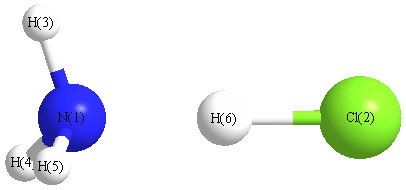Vibrational Frequencies calculated at HF/CEP-121G*
| Mode Number |
Symmetry |
Frequency
(cm-1) |
Scaled Frequency
(cm-1) |
IR Intensities
(km mol-1) |
Raman Act
(Å4/u) |
Dep P |
Dep U |
|---|
| 1 |
A1 |
3685 |
3329 |
1.73 |
106.13 |
0.04 |
0.08 |
| 2 |
A1 |
2777 |
2509 |
862.28 |
374.46 |
0.36 |
0.53 |
| 3 |
A1 |
1273 |
1150 |
194.40 |
0.35 |
0.75 |
0.86 |
| 4 |
A1 |
162 |
146 |
7.84 |
0.54 |
0.40 |
0.57 |
| 5 |
E |
3810 |
3442 |
5.28 |
61.45 |
0.75 |
0.86 |
| 5 |
E |
3810 |
3442 |
5.28 |
61.45 |
0.75 |
0.86 |
| 6 |
E |
1848 |
1669 |
32.61 |
7.15 |
0.75 |
0.86 |
| 6 |
E |
1848 |
1669 |
32.61 |
7.15 |
0.75 |
0.86 |
| 7 |
E |
656 |
593 |
102.26 |
1.66 |
0.75 |
0.86 |
| 7 |
E |
656 |
593 |
102.26 |
1.66 |
0.75 |
0.86 |
| 8 |
E |
222 |
201 |
18.32 |
2.05 |
0.75 |
0.86 |
| 8 |
E |
222 |
201 |
18.32 |
2.05 |
0.75 |
0.86 |
Unscaled Zero Point Vibrational Energy (zpe) 10484.2 cm
-1
Scaled (by 0.9034) Zero Point Vibrational Energy (zpe) 9471.4 cm
-1
See section
III.C.1 List or set vibrational scaling factors
to change the scale factors used here.
See section
III.C.2
Calculate a vibrational scaling factor for a given set of molecules
to determine the least squares best scaling factor.
Charges, Dipole, Quadrupole and Polarizability
Charges from optimized geometry at HF/CEP-121G*
Charges (e)
| Number |
Element |
Mulliken |
CHELPG |
AIM |
ESP |
| 1 |
N |
-1.033 |
|
|
|
| 2 |
Cl |
-0.369 |
|
|
|
| 3 |
H |
0.355 |
|
|
|
| 4 |
H |
0.355 |
|
|
|
| 5 |
H |
0.355 |
|
|
|
| 6 |
H |
0.336 |
|
|
|
Electric dipole moments
Electric dipole components in Debye
(What's a Debye? See section
VII.A.3)
| |
x |
y |
z |
Total |
| |
0.000 |
0.000 |
-4.477 |
4.477 |
| CHELPG |
|
|
|
|
| AIM |
|
|
|
|
| ESP |
|
|
|
|
Electric Quadrupole moment
Quadrupole components in D Å
| Primitive |
|---|
| | x | y | z |
|---|
| x |
-19.535 |
0.000 |
0.000 |
| y |
0.000 |
-19.535 |
0.000 |
| z |
0.000 |
0.000 |
-14.320 |
|
| Traceless |
|---|
| | x | y | z |
|---|
| x |
-2.607 |
0.000 |
0.000 |
| y |
0.000 |
-2.607 |
0.000 |
| z |
0.000 |
0.000 |
5.215 |
|
| Polar |
|---|
| 3z2-r2 | 10.430 |
|---|
| x2-y2 | 0.000 |
|---|
| xy | 0.000 |
|---|
| xz | 0.000 |
|---|
| yz | 0.000 |
|---|
|
Polarizabilities
Components of the polarizability tensor.
Units are
Å
3 (Angstrom cubed)
Change units.
| |
x |
y |
z |
| x |
2.495 |
0.000 |
0.000 |
| y |
0.000 |
2.495 |
0.000 |
| z |
0.000 |
0.000 |
4.058 |
<r2> (average value of r
2) Å
2
| <r2> |
62.571 |
| (<r2>)1/2 |
7.910 |
